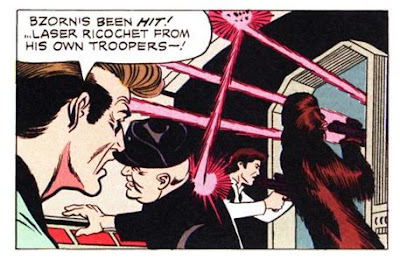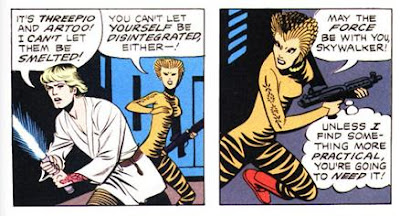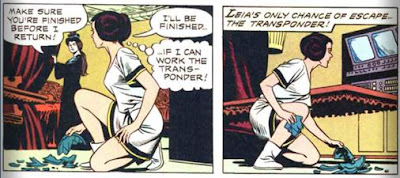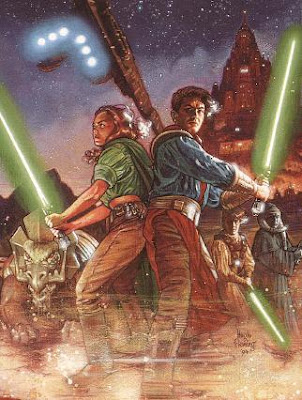
When Obi-Wan Kenobi said that the lightsaber was an elegant weapon from a more civilized time, the era of “Tales of the Jedi” was what he was talking about.
“Tales of the Jedi” is an extraordinary comic because it shows us a part of Star Wars we’ve never seen before: the era of the Old Republic, when Jedi Knights were numerous. If the time of the original Star Wars movies is comparable to the gritty and rough 1930s, these comics are set in 17th Century France; in fact, Ulic Qel Droma’s Samurai-inspired armor aside, the Jedi Knights have more the feel of the Musketeers, and it’s telling our main Jedi heroes are three young, hotshot male characters out to prove themselves.
The Krath
The principal villains of the story are the main attraction because they’re so gleefully well developed and wicked: the Krath, a society of cruel and decadent young aristocrats who dabble in the Dark Side and evil sorcery to alleviate their incredible boredom, who are not entirely aware of the evil they’ve unleashed on the universe. The Krath murder their parents and tutors in creative and sadistic ways, laughing all the way: murder and the macabre is a sport for them. They torture for the fun of it. The Krath are the super-rich equivalent of the kid in the neighborhood that used to place firecrackers up the assholes of stray cats.
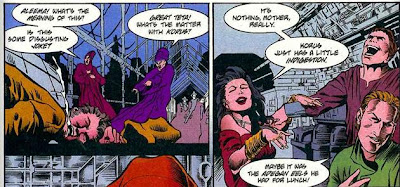

There’s a definite Edgar Allen Poe vibe from these guys; Poe loved twisted young aristocrats, warped by boredom, parental inattentiveness, a society that never told them “no” or set boundaries, and their own origins as bad seeds. The narrator of the Tell-Tale Heart evilly implored them to understand his awful murder done out of insanity:
“You who are rich and whose worries are few; might come around to see my point of view.”
The Krath are so horrifyingly decadent and evil they are absolutely fascinating, and their illusion powers are so chilling, turning swords into serpents. One thing that bothered me about the Sith in the godawful Star Wars prequel trilogy was the lack of imagination in Sith abilities, based on recycling imagery from the original movies like lightning bolts and lightsabers. The Sith here don’t use lightning, and certainly don’t use lightsabers. In fact one weapon that’s distinctively theirs is the Sith Sword, a monster thing that’s curved and evil.
Earlier I said the era of Tales of the Jedi was like the 17th Century. Just like the camaraderie of the Jedi was inspired by the Musketeers, it’s obvious the Krath were inspired by L’affaire des poisons (The Affair of the Poisons), a famous scandal where members of the aristocracy of France were found guilty of witchcraft, where in addition to crimes like convincing a lover to poison her parents, the society of aristocrats were fascinated by the Occult: fortune tellers, astrology and devil-worship.
The one downside to the Krath is the energy circle that surrounds their eyes when they use their evil sorcery. It’s so…well, X-Men, like something Psylocke would do.
(See if you can guess which is the Krath villainess and which is Psylocke.)
 Exar Kun, “Our Villain”
Exar Kun, “Our Villain”
I find it amazing that the least interesting villain in the comics is the one who keeps on getting referenced over and over in Star Wars. For instance, Exar Kun’s evil ghost was the main bad guy in the Jedi Academy trilogy. Like Lumiya and Lord Cronal (“Blackhole”), Exar Kun was one of the few expanded universe bad guys to have their origin in the comics.
It’s a shame his story is so predictable, so there’s no real drama in it. For heaven’s sake, just LOOK at the guy! He’s got scars and black hair and evil black robes and looks like Count Dracula. Doesn’t he just scream bad guy? The first time we see him he attacks his own master and is obsessed with evil knowledge. Gee, I wonder if this dick will turn to the Dark Side…
The Republic
The Republic is a little less like any governing body in Star Wars, and a lot more like the Federation from Star Trek: entrance in it is possible only for civilized worlds that have reached a certain level of development – that have “grown up,” basically. In fact, the primary plot of the first arc of Tales of the Jedi, “Ulic Qel-Droma and the Beast Wars of Onderon,” feels a little like one of the many Star Trek first contact episodes. The fact the Republic was such a surprisingly benevolent society in this era is really interesting because…what’s the point of decadence and decay if there was never anything better?
Ulic Qel-Droma, “Our Hero”
Of all the heroes in Star Wars, Jedi Knight Ulic Qel-Droma is the most like Flash Gordon and Buck Rogers, at least on the surface, anyway, and at least at first: he’s got a clefted chin and big muscles, a throwback to the fifties when Americans liked their heroes like they liked their steaks: beefy and All-American. Like Luke Skywalker, Qel-Droma’s a youth out to prove himself, and he’s way too arrogant and cocky for his own good, bold and without fear. Come to think of it, Tales of the Jedi has tons of Flash Gordon and pulp references, though as usual they’re subdued and not gaudy, like one alien is from the planet “Vultan.”
However, when Ulic’s master is murdered by a droid, the character’s arc takes a turn for the worst. His belief in his own invincibility becomes a liability when he suggests infiltrating the Krath to avenge his master’s death. Here we actually see how someone could fall to the Dark Side: filled with the best intentions, yet an absolute certainty and cockiness that nothing can happen to him, motivated by fear and loss. The moment he leaves is the most powerful part of Tales of the Jedi by far: it has the feeling of irrevocable loss. Everyone feels they’ll never see Ulic ever again, from his brother to Nomi Sunrider, the woman Ulic loves.

Our Heroine, Nomi Sunrider
Nomi Sunrider has the distinction of having her hair change more times than any other science fiction female except maybe Dr. Crusher. Take a look at this, and bear in mind these are sequential panels:
Her hair changes color constantly. This is probably because Nomi Sunrider, in her early appearances, has the most bizarre case of female pattern baldness I’ve ever seen. I think what they wanted to do was give her an unique and distinctive “Star Wars” hairstyle, much like Princess Leia’s Mexican peasant woman buns, but while Leia looked memorable this just looked icky and weird. If I tried to go for a Star Wars equivalent of a No-Prize, the explanation for the weird on/off hair may be that Nomi Sunrider has female pattern baldness (yes, it happens – ask any dermatologist) and occasionally wears a hairpiece.
Incidentally, I had to scan a lot of these images myself because when I did a Google image search for Nomi Sunrider for images to accompany this review, almost every single image – every one - that turned up was of Nomi Sunrider holding someone and crying!
The Continuity
The most amazing thing about Tales of the Jedi is that despite the fact it’s set in an inconceivably ancient era (4,000 years before the Star Wars movies) you get the feeling we’re midway into civilization, that even this time has a lengthy past behind it. When Obi-Wan said the Jedi had been protectors of the Republic for a thousand generations (that’s 20,000 years, give or take) he wasn’t exaggerating for effect.
There are already ruins and long-dead legendary figures like the Sith Tombs of Korriban (inspired by the Valley of the Kings) and Empress Teta (an Alexander the Great-esque military leader). As this is our only window into this era, every single mention of continuity here is overdeveloped and pounced on by the few other works set in this era like the Old Republic video game. An offhand mention in one line of dialogue of “a great droid revolution” was the basis for tons of lore, for instance.
By the way, Empress Teta has a really funny name to Spanish speakers because a Teta in Spanish is a slang term for giant breasts. There hasn’t been a funnier cross-linguistic accident in Star Wars since it was discovered “Panaka” is Portuguese for “douchebag.”
With a better special effects budget, it’s ironic the Jedi somehow became less interesting and had less mystique once they became ridiculous supermen who threw giant rocks around with mind powers, able to destroy armies. Also, the Jedi in this comic actually get married and have sex, as opposed to the emotionless and creepy monks they were in the prequel movies. Jedi in this era were great swordsmen, acrobats and martial artists with often unusual abilities to counteract sorcery, but for the most part their powers were subtle and not silly. As budgets improved, the Jedi got so invulnerable that there was no suspense or danger; ironically they became boring. Not so here. Andur Sunrider was killed by a gang of criminals and even a mighty Jedi Master was killed by a droid.
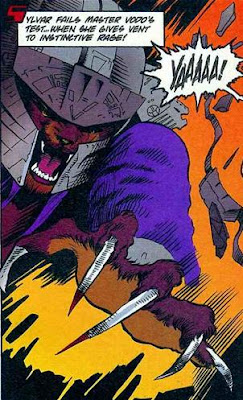
One character from this era I find amazing is the Cathay “animal Jedi” Sylvar, who at first is seen as this terrible feral cat monster that was roughly the series’s equivalent of Chewbacca, but gradually gets more and more sexed up and human looking for no reason. Lots of characters started off homely but got better looking and slimmer as time went on before anyone knew what was happening: Miss Piggy, Pepper Potts, the Wicked Witch of the West, and so on, but never to such an extreme from such bizarre and grotesque beginnings.
In the last “Tales of the Jedi” series, she’s gotten much more human and a lot better looking, inexplicably.
Finally, when she’s seen again in the 2005 video game Knights of the Old Republic, only little hints of her animal nature can be seen and she became a dead ringer for Cheetara from Thundercats, perfect masturbation fodder for nerds.

Incidentally, I have a few theories about some of the alien races from this era that vanished. The cat race of the Cathay had so much genetic diversity that eventually they speciated like Darwin’s finches, becoming the many cat-races in present day Star Wars like Atuarre’s race from “Han Solo at Star’s End.”
Also, here’s another fan theory of mine: the Noghri, Darth Vader’s personal assassins, are the last survivors of the original Sith species along with the Massassi on Yavin IV. It would explain their veneration for Darth Vader (an instinctive worship of evil fallen Jedi), and the assassin weaponry used by the Noghri is similar to the primitive weapons used by the Massassi: knives and throwing objects.
The Art and Design – or, “Why are there so many lines on the face? Why?”
“Tales of the Jedi” is one of the few comics I can think of that was a giant success despite the fact it didn’t have slick art. In fact the art is downright ugly, especially during the Nomi Sunrider arc. It’s laughably dated and borrows from Frank Miller in ways that are unintentionally funny. There's no greater contrast between the painted and photorealistic covers than the often amateurish interior art. It reminds me of Gold Key comics, who used painted covers as a selling point to make their books stand out on the shelves.
I mean, look at other big hit top sellers: “The Further Adventures of Indiana Jones” had John Byrne at the height of his fame and power, the Marvel Star Wars comics had possibly the best art of Walt Simonson’s career, Teen Titans was a superhit more due to the fact George Perez did the pencils than anything in the scripts, and I highly doubt anyone would have cared about Kingdom Come if George Tuska or Sal Buscema did the art instead of Alex Ross.
Why this comic so successful if the art was was so bad? Well, to start with, people were really hungry at this time for Star Wars: there hadn’t been any prequels yet to compromise Star Wars’s coolness and there hadn’t been any new Star Wars movies for going on 12 years.
Also, never underestimate the power of the international comics market. One of the things that strikes me about the letters pages from Dark Horse’s Star Wars comics is how the postscripts on the letters come from all over the world: Japan, Denmark, and Latin America. I love superhero comics a lot, but in many ways the popularity of superheroes are a strictly American phenomenon. Star Wars on the other hand, has more of a global audience.
The Nebulon Ranger is one of the worst designed starships I’ve ever seen; it looks like something Wreck-Gar would assemble on the Planet of Junk. In fact, nearly every starship looks like this in this era; asymmetrical, pointed, craggy junkers. The ships don’t have the personality and memorable design that the supercool Milennium Falcon did. Also…I don’t work for Lockheed-Martin or Boeing, so take my sense of the laws of avionics with a grain of salt…but wouldn’t having thrusters just on one side of the ship make it go around in circles? The only piece of technology that has any distinctiveness are the lightsabers: they almost always have this weird four-prong “castle” design. In fact, this design for lightsabers was maintained in things like the Old Republic video games.
In the end, while I liked Tales of the Jedi a lot, I got an overwhelming feeling this was produced by a writer that never worked for comics before, which is, to an extent, true: Kevin J. Anderson was principally a novelist. The stories, like wrongly-paced DC comics of the 1960s, relied on the captions for transition and to express action. Comics have a rhythm to them and a language used to express ideas; sometimes some things can be expressed in art; for instance, you can't have the captions say "everyone's heart was heavy when they were forced to abandon Ulic Qel-Droma," and then have the panels just be everyone sitting and talking with normal expressions.





























